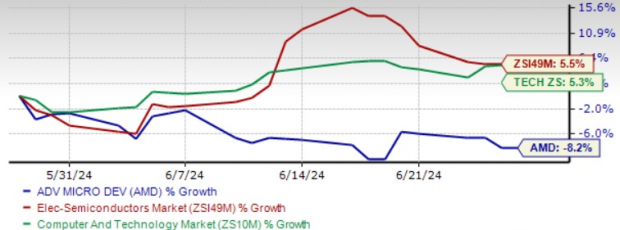Advanced Micro Devices (AMD) has witnessed a challenging period with its shares sliding over 8% in the previous month, amplifying its underperformance compared to the Zacks Electronics-Semiconductors industry and the Computer & Technology sector. In stark contrast, its major rival, NVIDIA (NVDA), has managed to rope in gains of 11% within the same timeframe.
The market’s sentiment is in flux towards AI chip providers as the macroeconomic landscape becomes more tumultuous and political uncertainty looms in anticipation of the upcoming Presidential elections. These factors have cast a shadow on the share prices of chip providers, especially impacting AMD given its smaller size and market share in the GPU realm compared to NVIDIA.
Evaluation of AMD Stock’s One Month Performance

Image Source: Zacks Investment Research
Nevertheless, the decline in AMD’s stock price might present a daring opportunity for investors willing to take risks. The AI sector is poised for continued strength, fueled by the augmented investments from major cloud computing players like Microsoft and Alphabet.
Tech research firm Gartner foresees a robust 19.1% CAGR in AI software spending from 2022 to 2027, surging to $297 billion by 2027. Deloitte predicts a 30% boost in enterprise spending on GenAI by 2024, up from $16 billion in 2023.
AMD’s strategic initiatives to broaden its product range position it to compete with NVIDIA not just in the data center segment but also in the expanding AI-driven consumer PC market for the long haul.
AMD’s Expansion Strategies and Promising Future
At Computex 2024, AMD introduced its roadmap for the Instinct accelerator, featuring the upcoming Instinct MI325X accelerator anticipated in the fourth quarter of 2024.
The next-generation CDNA 4 architecture slated for 2025 will power the AMD Instinct MI350 Series, promising up to 35 times better AI inference performance relative to the AMD Instinct MI300 Series with AMD CDNA 3. Following this, the CDNA “Next” design will drive the MI400 series accelerators planned for 2026.
AMD also rolled out the fifth iteration of its EPYC server processors named Turin, leveraging the Zen 5 core. The company’s portfolio received a further boost with the introduction of the Ryzen AI 300 Series, the third-gen AMD AI-enabled mobile processors, and Ryzen 9000 Series processors for laptops and desktop PCs.
Furthermore, AMD is capitalizing on its strong partner network. At Computex, tech giants like Microsoft, HP, Lenovo, and Asus unveiled new PCs equipped with third-gen AMD Ryzen AI 300 Series processors and AMD Ryzen 9000 Series desktop processors.
Market Competition and Its Impact on AMD
NVIDIA’s game plan of annual AI chip model launches, deviating from the previous two-year update cycle, intensifies the rivalry for AMD. Additionally, endeavors by tech powerhouses such as Microsoft, Alphabet, and Meta Platforms to develop their individual AI platforms pose a challenge for AMD.
Microsoft’s Maia 100 AI accelerator is engineered to handle cloud AI workloads like extensive language model training and inference. This accelerator is powered by a 5-nanometer TSMC process and boasts 105 billion transistors.
Alphabet’s Google has brought forth the Axion central processing unit (CPU) tailored for supporting its AI work within data centers. The Axion processors are the first bespoke Arm-based CPUs from Google designed to deliver robust performance and energy efficiency.
Meta Platforms’ Training and Inference Accelerator, a range of customized chips tailored for Meta’s AI workloads, bolsters new generative AI products and services, recommendation systems, and cutting-edge AI research.
AMD Stock Valuation: A Place for Caution
The current trading position of AMD stock reflects a discounted rate relative to NVIDIA and a mild premium compared to the Zacks Electronics-Semiconductors industry. With a forward 12-month P/E of 36.84X as opposed to NVIDIA’s 43X but marginally higher than the industry’s 34.83X, AMD’s attractiveness to growth-focused investors in the near term might be limited.
AMD’s performance estimates for the second quarter of 2024 indicate revenues of $5.7 billion (+/-$300 million). At the mid-point of this revenue projection, the company anticipates a year-over-year growth of approximately 6% and a sequential growth of around 4%.
The Zacks Consensus Estimate pegs AMD’s second-quarter 2024 revenues at $5.71 billion, translating to a 6.54% year-over-year growth rate. Earnings estimates hover around 66 cents per share, showing a slight decrease compared to the preceding 30 days.
Disclaimer: This article is for educational purposes only and does not constitute investment advice. Investors should conduct their research before making any financial decisions.